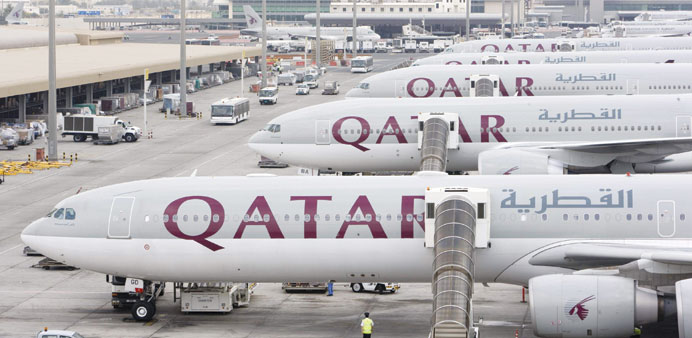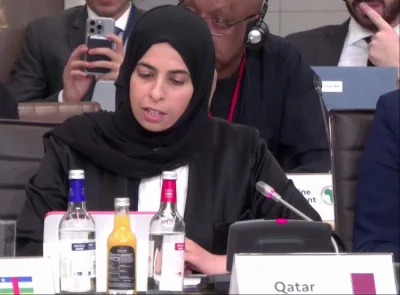|
Bosses from some of the world’s leading airlines will arrive in Doha next week for the biggest event hosted by national carrier Qatar Airways on home turf for years. |
Not a milestone anniversary; nor a celebration of another route launch; and not even the induction of a new aircraft type into its fleet.
The red carpet will be rolled out as a Boeing 777 is unveiled sporting a new livery amid fanfare in front of a large local and international audience. So much so that it will be streamed live on YouTube.
The airline executives will be joined by the world’s press to witness yet another career first for the home grown airline as it enters a new league in global aviation.
Next week marks a turning point in the history of the teenage carrier. It officially joins a family of 12 international airlines that form the global alliance known as oneworld.
As the heads of oneworld members British Airways, American Airlines, Japan Airlines, Cathay Pacific and Australia’s Qantas sit side by side with fellow airline partners and their Qatar Airways host, and joined by officials from across the alliance membership, the induction ceremony will be a grand affair.
Qatar Airways’ meteoric rise in just 16 years of operations has seen the airline’s iconic Oryx tail fin proudly flying the flag for the State of Qatar to over 130 destinations across the world.
Past midnight on October 29, its route network will multiply seven-fold under the guise of the oneworld umbrella to over 800 destinations – and this, without Qatar Airways opening up any new routes of its own. The Doha-based carrier’s global reach will expand overnight due to the advent of alliance marketing.
All flights will be marketed as oneworld services offering a range of travel benefits, allowing frequent flyers to “earn and burn” loyalty miles on member airlines; giving them access to more airport lounges worldwide; offering passengers attractive fares on multi-sector flights served by partners carriers; and booking convenient itineraries through more co-ordinated schedules.
For Qatar Airways, improved display of routings in airline reservation systems and on display screens at airports it doesn’t operate to, provides instant brand exposure.
Fresh from the paint shop, the Boeing 777 featuring huge oneworld lettering across its fuselage will take off on long-haul flights showing the world that Qatar Airways has begun a new chapter in its illustrious history. This will be one of a handful of aircraft to fly in the new livery over the next few weeks.
It also heralds a significant move in the region’s aviation sector with Qatar Airways becoming the first of the big three Gulf carriers – the others being Emirates and Etihad – to be lured by any of the big three global alliances operating today.
So what is all the fuss about? Why have alliances become a talking point? And why has Qatar Airways taken the plunge after resisting any temptation to join much earlier?
The answer lies in market strength, global reach, passenger loyalty and resource sharing.
Market strength: reach destinations with partners which one airline cannot do alone.
Global reach: expand to markets by providing passengers with greater travel options. More people want to fly to more places more easily and, for more value.
Loyalty: develop the customer base by attracting frequent flyers of alliance members and offer existing members more travel benefits.
Share resources: a cost-saving exercise to potentially share airport facilities such as check-in areas, terminals and other airline services with partners.
During times of economic crisis in many parts of the world, the latter helps keep costs under control and revenue targets in line.
Qatar Airways has successfully shaped its business model on high quality of service that industry peers have admired with envy over the years. But despite billions of dollars injected in new aircraft and new routes to strengthen its global presence, it cannot possibly reach every destination in the world single-handedly. Neither can other airlines.
In a recent column, I stressed how difficult it was for airlines to operate certain routes because of restrictions posed by over-protective governments of their own national airlines fearing market share could be eroded by a new entrant in the marketplace.
In fact, it isn’t economically feasible for an airline to operate flights on particular routes even if it had the traffic rights due to insufficient demand and the prohibitive cost that may far outstrip the projected revenue.
For as much alliances talk of benefiting the customer, they also positively impact an airline’s bottom line.
Alliances have actually been around for over 60 years as every airline has some form of relationship with one another.
Whether it is a basic ticketing arrangement in which a passenger can be booked on more than one airline to complete a multi-sector journey – commonly known in the industry as interlining, or carriers moving up a gear to co-operate on routes pending permission from the relevant authorities, partnerships have grown from strength to strength.
From interlining, carriers then looked at applying their flight codes on each other, otherwise known as code sharing, in which one or more airline shares the seat allocation on a particular flight.
The operating airline benefits because it gets revenue from another carrier, while the latter benefits by offering passengers in its home market more route options without actually operating the flight. A win win situation for all.
Code sharing was prevalent in the 90s, but it wasn’t until the emergence of alliances that such a marketing practice became even more rampant.
Before the days of the current big three alliances, Dutch carrier KLM and Northwest in the US took the plunge in 1989 to form the first ever strategic alliance agreement in which they shared revenue on jointly-operated flights across the Atlantic.
They co-ordinated flights between their respective transatlantic hubs of Amsterdam, home to KLM, and Northwest’s Detroit and Minneapolis.
The bilateral partnership eventually ended, only to be superseded by the might of the global alliances.
KLM later joined oneworld competitor SkyTeam, which also lured Northwest following its merger with another US carrier, Delta Air Lines.
In an industry that continues to face reeling costs related to fuel, labour, airport charges and the ever-changing global economic climate, every airline has to make concerted choices as part of their strategic planning to develop their business.
Today’s aviation world is now a large jigsaw made up of three alliance players, all formed within the space of three years. The pioneer Star Alliance created in 1997; oneworld launched in 1999; and SkyTeam set up a year later.
Collectively, they are estimated to account for almost two-thirds of the total world airline seat capacity and more than 80% of air travel expenditure between the world’s top 100 business cities. The airport hubs of member airlines play a pivotal role in the strength of the three.
All started off small in numbers with airline industry heavyweights behind each alliance launch.
The aim was to create and develop a network and spearhead a membership push to strive for global dominance. Taking advantage of regional strength in different parts of the world and using the power of airport hubs to maximise flight connections and destination coverage was the ultimate objective.
In the case of Star Alliance, its five founding members of United Airlines, Lufthansa, Thai Airways, Air Canada and Scandinavian Airlines (SAS) have seen its support network rise sharply to almost 30 carriers and their affiliates. Many industry observers have argued the alliance has grown out of control because of its sheer size.
The US hubs of Chicago, Washington, San Francisco, New York and subsequently Houston following a merger with Continental Airlines provided United Airlines with huge leverage in the world’s largest air transport market.
Lufthansa’s power base of Frankfurt, Thai’s Bangkok, SAS’s main centre of Copenhagen and Air Canada’s four biggest cities including Montreal and Vancouver, proved to be a good mix of regional centres to kick off the alliance. North America, Europe and Asia were well covered.
A similar philosophy of network reach was to follow as industry giants British Airways, American Airlines, Qantas, Cathay Pacific and the now defunct Canadian Airlines teamed up as launch partners of the competitor alliance, oneworld.
The attractive proposition: British Airways’ prime London Heathrow hub; Cathay’s Hong Kong base; Canadian’s Toronto and Vancouver operational centres; American’s bases at Miami, New York, Chicago and Dallas; and Qantas’ Sydney and Melbourne.
With SkyTeam joining the alliance bandwagon, the global picture looked a lot clearer. Founders Aeromexico through its Mexico City hub, Air France and its Paris Charles de Gaulle base, Delta Air Lines with its Atlanta heartland and Korean Air’s Seoul operational centre, had joined forces. SkyTeam’s membership now exceeds 20 airlines.
For the last 13 years no new alliances have formed. Airlines have either joined the existing alliances or created fresh relationships and deepened existing ones on a bilateral one to one basis in preference to joining a global alliance.
In the case of Emirates and Etihad, they have distanced themselves from the alliance scenario.
Dubai’s Emirates has instead focused on building a global network with its entire fleet of almost 200 wide body aircraft to destinations worldwide, now exceeding 130. Confident of its global presence and marketing muscle through scores of mass market sponsorships, it believes in taking control of its own operations and not be influenced by the complexity and politics that potentially go with any of the multi-airline alliances.
However, events took a dramatic turn last year when Emirates teamed up with oneworld founder Qantas to form a joint venture bilateral alliance and provide passengers with convenient access to their combined networks via Dubai and hubs served by the Australian carrier Down Under.
Such a tie-up has raised questions about Qantas’ commitment to the oneworld partnership, given that long-standing revenue-sharing bilateral relations with British Airways between the UK and Australia faded before the Emirates link-up became public. And with rivals Qatar Airways now in the oneworld fold, what will be Qantas’ level of co-operation be, now that the Oz carrier has Emirates as a bed fellow?
Earlier this year, Qantas moved its south-east Asia transit hub to Dubai to serve flights on the popular kangaroo route between Australia and the UK. With Dubai opened up as a new hub for Qantas, and Emirates’ multi-frequencies to Europe and Australia, both airlines have combined their operations to offer more joint services on the kangaroo route.
In the case of Etihad, the Abu Dhabi-based airline has expanded its global reach through equity alliances – buying into airlines and code sharing rather than forming any form of marketing tie-up with groups of airlines.
Having made equity investments in Air Berlin, India’s Jet Airways, Irish carrier Aer Lingus and Virgin Australia, Etihad firmly believes that progress must be made through a mix of organic growth and strategic partnerships.
Acknowledging global reach is beyond the capacity of any single airline, Etihad states that equity investments by far deliver synergy benefits which cannot be achieved through airline alliances.
Legacy alliances, it argues, focus on network and revenue benefits while equity alliances deliver broader benefits for all partners, including opportunities to reduce operational costs through sharing resources and joint procurement of services.
With Etihad’s Air Berlin in the oneworld camp and the Emirates/Qantas relationship under ongoing scrutiny, the aviation media gathering in Doha will certainly have some thought-provoking questions at the highly-anticipated oneworld CEO press conference next week.
Alliances are not as simple as they seem in the high-flying world of aero politics.
♦ Updesh Kapur is a PR & communications professional, writer and aviation and travel specialist. He may be contacted on [email protected]



